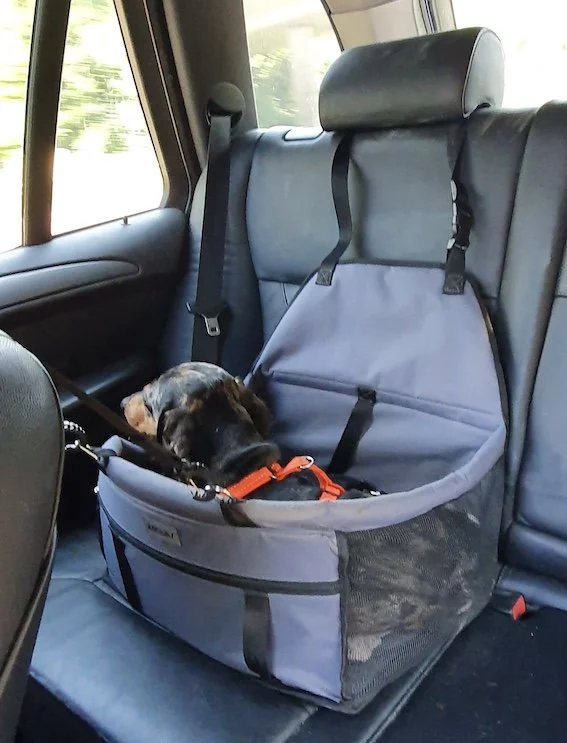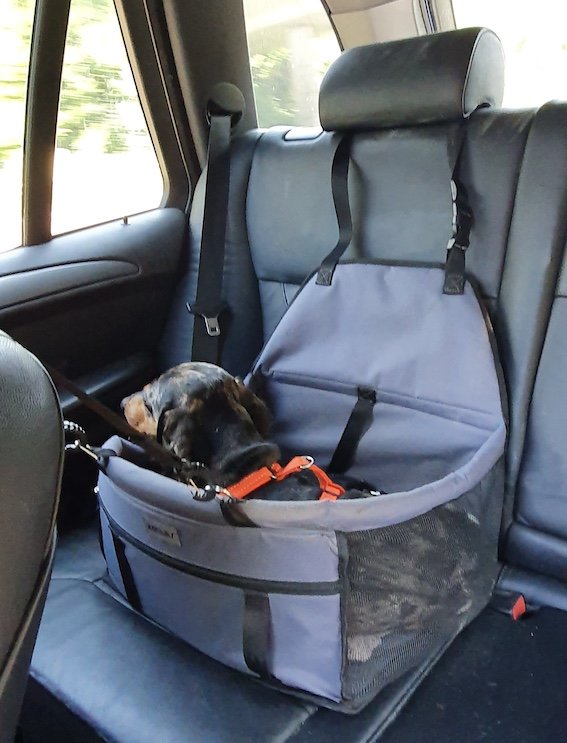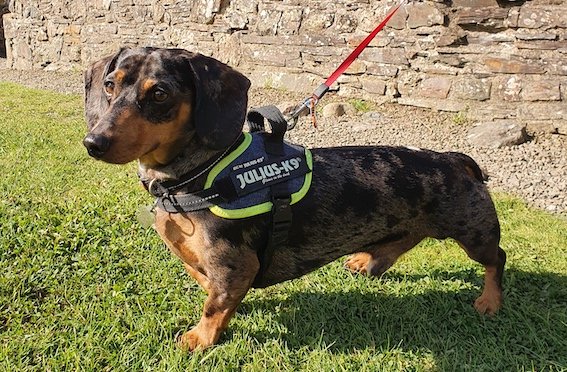12 Tips For Stress-Free Car Travel With Your Dachshund
Travelling with your dachshund can be a delightful adventure, and opens up the possibility of visiting lots of new places together with your pet – even possibly going on a dog-friendly holiday! But for some dachshunds, and actually dogs in general, car rides can be a source of stress and even lead to issues like car sickness.
We have found that our dachshund can tend to get over excited in the car and will whine and howl in anticipation of where we’re going, as he has learned to associate being in the car with doing something fun, like going for an exciting new walk or going to visit family! So getting on top of keeping him calmer in the car has been a real journey for us.
To ensure that your sausage dog enjoys the journey in the car as much as the destination, here are our 12 tips for a smooth ride:
1. Gradual Introductions
It’s a good idea to ease your dachshund into the concept of car travel by incorporating gradual introductions. Start with short rides to destinations that your dog enjoys, like a nearby park or a friend’s house. This approach helps create positive associations with car rides, making the experience more enjoyable for your dachshund. Begin with brief journeys, gradually extending the duration as your dachshund becomes more comfortable. Patience is key, and reinforcing positive behaviour during and after each trip with treats and praise will further solidify the positive connection with car travel.
Introducing your dachshund to the car gradually allows them to adjust to the experience, reducing anxiety. These small, positive steps lay the foundation for a stress-free journey and enjoyable relationship between your dachshund and car rides.
2. Comfortable Seating
Investing in a comfortable and secure car seat or travel crate for your dachshund is crucial. Providing a designated and comfortable space reduces anxiety and ensures a sense of security during the journey. Consider the specific needs and preferences of your dachshund when selecting the seating arrangement. This dedicated space becomes a familiar and safe zone for your pet, contributing to a more relaxed and enjoyable car travel experience.
A well-chosen car seat or travel crate for your dachshund not only enhances comfort but also serves as a practical measure for ensuring the safety of your dachshund during transit. We tested out a few different options for securing our boy in the car before we settled on a secure crate with ISOFIX points for ease and comfort. The investment in a suitable seating arrangement pays off in terms of a more pleasant journey for both you and your dog.

3. Familiarity Inside the Car
Before embarking on a journey, allow your dachshund to explore the inside of the stationary car. This pre-travel ritual lets them become familiar with the environment, reducing potential stress during the actual car journey itself. Encourage exploration by placing treats or toys in the car, rewarding calm behaviour with positive reinforcement. By creating positive associations with the car’s interior, you contribute to a more relaxed and confident traveller.
Rewarding your dachshund for calm behaviour inside the car reinforces the idea that car rides are enjoyable experiences. This gradual introduction to the vehicle environment, paired with positive reinforcement, helps build a strong foundation for a harmonious travel relationship with your dachshund.
4. Ventilation
Ensuring proper ventilation within the car is essential for your dachshund’s comfort during travel. While cracking open windows slightly allows fresh air circulation, be cautious of strong winds to prevent discomfort. Alternatively you can use climate control or air conditioning to get suitable ventilation and the right temperature in the car.
Adequate ventilation helps alleviate any potential nausea or discomfort associated with a lack of fresh air. Striking the right balance creates a pleasant and well-ventilated environment, contributing to a more enjoyable car journey for your dachshund.
Well-regulated ventilation not only prevents motion sickness but also enhances the overall travel experience, ensuring a comfortable and safe journey for your dachshund.
5. Scheduled Meals
To minimise the risk of car sickness, avoid feeding your dachshund right before the journey. Instead, schedule meals a few hours prior to departure. This approach reduces the likelihood of digestive discomfort during the ride, contributing to a more pleasant travel experience for your pet. By managing meal timing, you address the potential for nausea and create a more comfortable journey overall.
Scheduled meals not only contribute to physical wellbeing but also play a significant role in ensuring a calm and content dachshund during car rides, and can make a substantial difference in your pet’s comfort and enjoyment during travel.
6. Hydration
Maintaining your dachshund’s hydration during car trips is crucial. If you’re taking a long car journey, offer small sips of water during pit stops to keep them refreshed without over hydrating. Striking the right balance ensures your pet remains comfortable without the need for frequent toilet breaks. Hydration, when managed appropriately, contributes to a more relaxed and enjoyable travel experience for your Dachshund.
Providing opportunities for hydration during breaks not only addresses your dachshund’s physical needs but also contributes to their overall wellbeing and comfort. Managing water intake strategically helps maintain a pleasant and stress-free journey for your dog.
7. Frequent Breaks
Plan regular stops for toilet breaks and short walks during car journeys, especially if you are travelling over longer distances. These breaks not only address your dachshund’s physical needs but also allow them to stretch their legs and release built-up energy. Incorporating frequent stops contributes to a more comfortable and enjoyable travel experience, promoting your pet’s wellbeing throughout the journey.
One of the longest car journeys we have taken our dachshund on was a trip to the New Forest, which was about 3-4 hours in the car, and we aimed for a break about once an hour to give our dog the chance for a toilet and drink stop, and to stretch his legs.
Frequent breaks serve as essential opportunities for your dachshund to relieve themselves, ensuring their comfort and reducing potential stress associated with prolonged travel.
8. Secure Restraint
Prioritise safety by using a pet seat belt or a travel crate to secure your dachshund during car journeys. Unrestrained pets can pose a distraction and a safety risk. In fact, in the UK, rule 57 of the Highway Code states that animals must be securely restrained in the car making this a legal requirement too!
Implementing a secure restraint not only safeguards your dachshund but also contributes to a focused and stress-free driving environment. Prioritising safety measures establishes a foundation for a secure and enjoyable travel experience for both you and your pet.
9. Positive Reinforcement
It’s also a good idea to encourage positive behaviour during car rides through the consistent use of treats and praise. This is a general tip when training your dachshund, but can really help in the car too. Rewarding your dachshund for calm behaviour reinforces the idea that car trips are enjoyable experiences. This positive reinforcement strategy creates a connection between good behaviour and pleasant car journeys, contributing to a more relaxed and cooperative travel companion.
Consistent positive reinforcement builds a positive association between your dachshund and car travel, making each journey a rewarding and enjoyable experience.
10. Desensitisation to Motion
Firstly, gradually expose your dachshund to sitting inside the car while it’s stationary. Once comfortable, you can start to progress to short drives, gradually increasing the duration, to gradually desensitise them to the motion of the car. This step-by-step approach helps build tolerance and reduces the likelihood of motion sickness during longer journeys. Patience and positive reinforcement play key roles in desensitising your dachshund to the motion of the car.
Desensitisation to motion contributes to a more confident and comfortable traveller. By slowly introducing your dachshund to the sensation of movement and associating it with positive experiences, you pave the way for stress-free and enjoyable car rides for both you and your pet.
11. Calming Aids
If your dachshund gets very stressed in the car, you can also consider using calming aids, such as a familiar blanket or a favourite toy, to provide comfort during car journeys. Some dachshund owners find success with products like calming sprays or pheromone collars, which can have a soothing effect on anxious pets. Introducing familiar items and calming aids helps create a reassuring environment, promoting relaxation and reducing stress during travel.
Calming aids also offer support in creating a positive and comfortable atmosphere within the car. By incorporating familiar items and products intended to alleviate anxiety, you can enhance your dachshund’s overall wellbeing and contribute to a more pleasant travel experience.
12. Consult Your Vet
If your dachshund continues to experience car sickness or anxiety, it may be a good idea to consult your vet. A professional can provide valuable advice on potential solutions or recommend medication to ease your dachshund’s motion-related discomfort. A vet’s guidance ensures that you address any underlying health concerns and receive tailored recommendations to make car travel a more manageable and positive experience for your dachshund.
Consulting your vet also adds an extra layer of professional insight to your efforts in ensuring your dachshund’s wellbeing during car journeys. With their expertise, you can explore additional strategies or interventions to address specific issues and make the travel experience as comfortable as possible for your dog.
By incorporating these tips into your travel routine, you can transform car rides from a potential source of stress to an enjoyable experience for both you and your dachshund. Remember, patience and positive reinforcement go a long way in making every journey a tail-wagging success!







